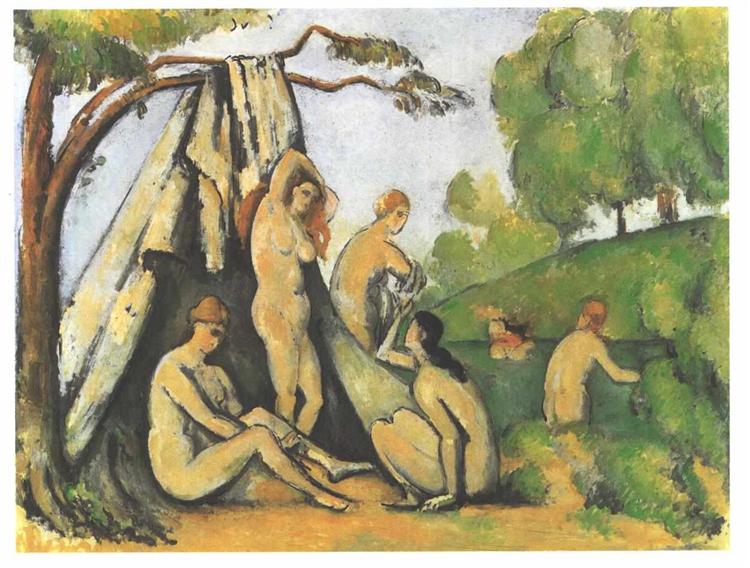The Large Bathers. Philadelphia Museum of Art Philadelphia, United States. Voiceover: We're looking at Paul Cezanne's The Large Bathers in the Philadelphia Museum of Art.

In the foreground, two women are seated beside the water, and a third is standing in the water near them. Our artists start with a blank canvas and paint each and every brushstroke by hand to re-create all the beauty and details found in the. Cézanne's great achievement forced the young Picasso, Matisse, and many other artists to contend with the implications.
In general, the style of this work is viewed as transition from Impressionism to modern arts. It is occasionally termed as 'Big Bathers'. The Bathers is currently located in the Philadelphia Museum of Art.
Cézanne's early work is often concerned with the figure in the landscape and includes many paintings of groups of large, heavy figures in the landscape, imaginatively. Voiceover: We're looking at Paul Cezanne's The Large Bathers in the Philadelphia Museum of Art. It is exceptional among his work, however, in the marked symmetry and the adaptation of the nude forms to the triangular.
It is also, perhaps, in its unfinished state, the purest and most serene witness to the man whom Paul Gauguin.
Historically artists took inspiration from classical myths.
Documentation: Tamar Garb examines Cézanne's Large Bathers from a sensory and psychological viewpoint: "Cézanne's art was tied to a new mode of looking, one which was embedded in the late nineteenth-century obsession with an art of sensation, an art adequate to the processes of vision, an art which could subsume the integrity of the. The Large Bathers was composed in Post-Impressionist Age of art. The subject of bathers is one that has a long history, think of paintings of Diana and Actaeon, by artists like Titian and Rubens, for example, artists like Degas were grappling with how to paint the nude in a modern environment.
The work depicts a group of women bathing on a beach. Philadelphia Museum of Art Philadelphia, United States. Philadelphia Museum of Art Philadelphia, United States.
Documentation: Tamar Garb examines Cézanne's Large Bathers from a sensory and psychological viewpoint: "Cézanne's art was tied to a new mode of looking, one which was embedded in the late nineteenth-century obsession with an art of sensation, an art adequate to the processes of vision, an art which could subsume the integrity of the. The painting is in the Philadelphia Museum of Art, in Philadelphia. Cézanne's great achievement forced the young Picasso, Matisse, and many other artists to contend with the implications.
As a way to counter the Impressionist use of naturalism in their light and color, Post. Thus, this piece is often referred to as "The Large Bathers.". Cézanne's early work is often concerned with the figure in the landscape and includes many paintings of groups of large, heavy figures in the landscape, imaginatively.
It is also, perhaps, in its unfinished state, the purest. Paul Cézanne's painting, The Large Bathers, has influenced many artists, particularly those that include nude figures in their work. It is occasionally termed as 'Big Bathers'.
This painting was created by Paul Cézannes and.
In fact, the high price produced something of a local scandal..
The Large Bathers. "The Large Bathers" is a series of paintings. The Large Bathers was composed in Post-Impressionist Age of art. Large Bathers holds a significant place in art history, in its innovation and originality it influenced a future generation of artists.
Our artists start with a blank canvas and paint each and every brushstroke by hand to re-create all the beauty and details found in the. Large Bathers holds a significant place in art history, in its innovation and originality it influenced a future generation of artists. Le bonheur de vivre Le bonheur de vivre is the most famous work painted by Henri.
This paper will analyze how both Matisse's Bonheur de Vivre (Joy of Life) and Picasso's Les Demoiselles d'Avignon can be seen as direct results of inspiration originated from probably the most recognized work painted by Paul Cézanne's, "The Large Bathers". Philadelphia Museum of Art Philadelphia, United States. In the foreground, two women are seated beside the water, and a third is standing in the water near them.
This paper will analyze how both Matisse's Bonheur de Vivre (Joy of Life) and Picasso's Les Demoiselles d'Avignon can be seen as direct results of inspiration originated from probably the most recognized work painted by Paul Cézanne's, "The Large Bathers". This essay will describe how two of those artists in particular, Henri Matisse and Pablo Picasso, have been inspired by and broken free of this particular Cézanne painting. This is the largest, the last, and in many ways, the most ambitious work from Cézanne's lifelong exploration of the time-honored theme of nudes in a landscape.
We utilize only the finest oil paints and high quality artist-grade canvas to ensure the most vivid color. Cézanne's great achievement forced the young Picasso, Matisse, and many other artists to contend with the implications. Cézanne, however, was not depicting a mythological story.
Philadelphia Museum of Art Philadelphia, United States.
In general, the style of this work is viewed as transition from Impressionism to modern arts.
Philadelphia Museum of Art Philadelphia, United States. It is occasionally termed as 'Big Bathers'. As a way to counter the Impressionist use of naturalism in their light and color, Post.
This work is located in the Philadelphia Museum of Art in Philadelphia, Pennsylvania. It is exceptional among his work, however, in the marked symmetry and the adaptation of the nude forms to the triangular. It is also, perhaps, in its unfinished state, the purest.
This work is located in the Philadelphia Museum of Art in Philadelphia, Pennsylvania. This essay will describe how two of those artists in particular, Henri Matisse and Pablo Picasso, have been inspired by and broken free of this particular Cézanne painting. This paper will analyze how both Matisse's Bonheur de Vivre (Joy of Life) and Picasso's Les Demoiselles d'Avignon can be seen as direct results of inspiration originated from probably the most recognized work painted by Paul Cézanne's, "The Large Bathers".
Our artists start with a blank canvas and paint each and every brushstroke by hand to re-create all the beauty and details found in the.
It is considered one of the most popular masterpieces of Paul Cezanne.
Documentation: Tamar Garb examines Cézanne's Large Bathers from a sensory and psychological viewpoint: "Cézanne's art was tied to a new mode of looking, one which was embedded in the late nineteenth-century obsession with an art of sensation, an art adequate to the processes of vision, an art which could subsume the integrity of the. Thus, this piece is often referred to as "The Large Bathers.". Created by Beth Harris and Steven Zucker.
Le bonheur de vivre Le bonheur de vivre is the most famous work painted by Henri. The painting depicts a scene of nude women bathing. The subject of bathers is one that has a long history, think of paintings of Diana and Actaeon, by artists like Titian and Rubens, for example, artists like Degas were grappling with how to paint the nude in a modern environment.
It is currently located in the Musée d'Orsay in Paris, France. Philadelphia Museum of Art Philadelphia, United States. Although this painting depicts a fleeting moment when one bather playfully threatens to splash a companion, it has a timeless, monumental quality.
This work is located in the Philadelphia Museum of Art in Philadelphia, Pennsylvania. Cézanne's great achievement forced the young Picasso, Matisse, and many other artists to contend with the implications. Thus, this piece is often referred to as "The Large Bathers.".


















